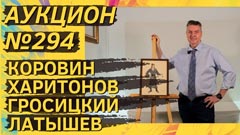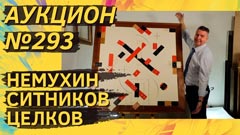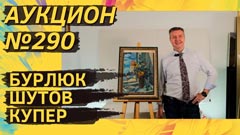
1960s UNOFFICIAL ART
NEMUKHIN Vladimir Nikolaevich (1925–2016) Super Elephant. 2010. Oil on canvas. 100 × 100
Meter-sized, powerful, museum-level! Mammoth in the world of “Super Elephants”! A giant standing in the water, constructed of suprematic blocks, is one of the most recognizable subjects in Nemukhin's work. In addition, it is usually without cards, which gathers for it an additional army of admirers. “Volodya, draw me a super elephant,” collectors tugged at his sleeve. And the artist didn't offend anyone, creating an entire herd of black, gold, and even pink elephants.
And before us today is a classic one — with a red circle. According to one version, it was exactly the red circle that became the starting point. Only the image was born not from the work of Malevich, but under the impression of the red sun in the painting by Julius Klever, which Nemuhin saw on a visit to a collector. However, it is possible that this is just one of the beautiful legends that were born after the success of the series.
Today, this image is so inseparable from the artist's name that it seems that Nemukhin always had elephants. But this is not the case. That plot is late by the standards of his work. The first elephants (still without the prefix “super”) appeared, apparently, in the early 1990s. For comparison, Nemukhin's cards, “rooster game” and “jacks” appeared almost thirty years earlier. In the first elephants, Nemukhin found the classical form and proportions, but the “correct palette” appeared even later. But one way or another, the era of the super elephants lasted almost 25 years.
During that time, the artist certainly created many dozens of variations of this subject. But the paradox is that, these days, this widespread subject remains a rarity. If you try to buy one, you'll have to wait a long time for a good chance. All the herd has long been scattered in collections, and fans of Nemukhin's work are in no hurry to part with the largest land mammal. So now is a rare chance. In addition, in front of us is the largest “Super Elephant” of all those offered at auction.
RABIN Oscar Yakovlevich (1928–2018) Three lamps. 1978. Oil on canvas. 51 × 61
The painting “Three lamps” was painted in 1978, a fateful year for Oscar Rabin. It was his first year in exile and the year of deprivation of citizenship. On June 22, 1978, at the Soviet Consulate in Paris, the artist was read a telegram with a decree of the Presidium of the Supreme Soviet of the USSR — to deprive Rabin of Soviet citizenship, because his activities “dishonor the title of a Soviet citizen”.
How could it be otherwise? Instead of production feats, the artist painted shabby barracks and vodka-herring as a metaphor for the everyday passions of a Soviet man. And instead of bowing low to the MOSKh superiors he demanded the right to exhibit, had the audacity to communicate with Western diplomats and dealers. And then he organized an exhibition in a wasteland in Belyaevo, the demolition of which led to a scandal and disgrace to the whole world.
And here is the first year of freedom. Paris. France. What has changed in Rabin's manner? Not much so far. The artist still thinks in images of the distant Lionozovo. His palette is still heavy and gloomy. New colors have been added just a little bit. French colors change the palette. And the laconic signature is already in Latin. Otherwise, it is still classic Rabin — and it is no coincidence that the early French period is valued almost as highly as the pre-emigration Lianozovo period.
Unraveling the riddle of “Three lamps” is an interesting task for the viewer and art historians. The pair of “Ilyich bulbs” opposite the smoking “Betty lamp” is obviously a philosophical metaphor of the conflict of new and old — progress against tradition. Note, however, that the incandescent bulbs do not shine. Blown out? No electricity? Only the kerosene lamp has a flicker of light.
BELENOK Petr Ivanovich (1938–1991) Conversation. 1989. Hardboard, mixed media. 49.5 × 39.5
The painting “Conversation” is a chamber format by the standards of Belenok. Such a painting is not meant to take over the space of a room. It doesn't pull the blanket over itself. But it is able to successfully balance the already built composition. And it will certainly quickly find a place on the wall in a large established collection.
This is one of those paintings that draws you in not by scale but by mood. The man and woman no longer look into each other's eyes, the words fly away like a red balloon, and someone else is watching them from afar.
A rare plot. Unconditional recognizability. Comfortable size and affordable price.
TSELKOV Oleg Nikolaevich (1934–2021) Four white sculptures. 2011. Porcelain
Tselkov's porcelain sculptures were produced at the Höchster Porzellan-Manufaktur in very small numbers: 15 black and 15 white, like ours. This is almost the only example of the transformation of characters from painting to sculptural form in all the porcelain of the artists of the sixties. In addition, this is probably the most spectacular sculptures of this genre in principle. All the others have plates, vases, dishes and cups. Only Tselkov and Boris Orlov have figures. And, more recently, Yankilevsky.
Over the past ten years figures from this series have virtually disappeared from circulation. They have settled in collections. They do not appear at the auction market every year. Moreover, many of them were bought individually. And to collect all the characters in one place is a task all the more non-trivial. But here is a chance. A complete set. Each one with its circulation number. Each one signed. All immaculately preserved. As if just they come off the pages of the catalog “Porcelain of the Sixties”.
CONTEMPORARY ART
VOLIGAMSI Rinat (1968) Ioan. 2005. Oil on canvas. 100 × 80
This time the twenty-first-century absurdist is armed with the tools of a fifteenth-century aristocratic ceremonial portrait in the style of Piero della Francesca. Ioan with one “n” is a character of mystery. The severe profile, the shaved ornamentation, and, of course, the two mouths! More and more metamorphoses are happening to him. A year earlier Voligamsi had painted another portrait of Ioan. Here he was dressed in a tailcoat and his face was decorated with wallpaper ornaments. Only two pairs of lips remained unchanged. And in our version, Ioan had changed from a tailcoat to a military jacket, an ominous metaphor for the times.
Rinat Voligamsi is an outstanding contemporary absurdist artist whose work we recommend for inclusion in an investment collection. An artist who speaks an emphatically ultramodern language, he has already become a favorite of collectors and merchandising businessmen. In his works, realistic images and scenes are deliberately unbalanced by incredible texture. Instead of doves, there are tiny dinosaurs. Instead of stars on cockades, there are constellations. Instead of a figure sprawled out in an armchair, a disembodied weave of legs. Our “Ioan” certainly occupies a worthy place in this line. Only this work is not humorous, it is a worldview piece. Museum level! A powerful combination of strong painting and a large, one-meter size.
KOSHLYAKOV Valery Nikolaevich (1962) Dionysos-Dushara. 2000. Canvas, collage, mixed media. 145 × 125
One and a half meters. Canvas. Museum Koshlyakov, period!
Valery Koshlyakov is among the most expensive contemporary Russian artists. Recall that his auction record is $147,000. He is a world star, a participant of international biennales, he has been living and working in France for a long time. His paintings are timeless. They are perfectly organic both for any collection of Russian art of the 1990s, as well as for any European collection.
Dialogue with antiquity is a major theme in Koshlyakov's work. This time the centerpiece is a bas-relief with the head of the god Dionysos-Dushara from the American Metropolitan Museum of Art. It once adorned the streets of the city of Petra, the capital of the ancient Nabataean kingdom, on the territory of present-day Jordan. Dushara was considered by the ancient Nabataeans to be the god of agriculture and winemaking. Hence the second name, Dionysos, a transfer and reference to the more famous ancient Greek hierarchy.
- Log in to post comments










